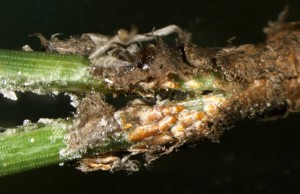Oystershell Scale (Lepidosaphes ulmi)
GDD Window (base 50): 363-707 (egg hatch and crawler emergence)
Overview:
- Overwinter as tiny white eggs under the waxy cover of the female
- Eggs hatch into pale yellow, less than 1mm long, crawlers
- Crawlers settle to feed & reach maturity in late summer/early fall
- This armored scale is among the most cold-tolerant of scale species
- Females are 3.0 mm long with a waxy cover, grayish brown, and resembling miniature oyster shells in shape and color
- One generation per year in NJ
- Branches become encrusted with scales
- Causes twig or branch dieback
- Trees and shrubs can die if high infestations are not managed
- Host plants: fruit trees, beech, birch, maple, poplar, willow, & lilac and boxwood shrubs
Management:
Cultural Practices:
- Natural predators: brown lacewings, green lacewings, lady beetles, parasitic wasps
- Keep growing areas and equipment clean
- Prevent dusty conditions
- Reduce plant stress
- Dispose of heavily infested plants
Materials:
- Contact insecticides:
- Carbamates [1A]: carbaryl
- Pyrethroids [3A]: –thrins
- Organophosphates [1B]: acephate (translaminar), malathion
- Systemic insecticides:
- Neonicotinoids [4A]: dinotefuran, acetamiprid, thiamethoxam
- Considerations:
- Will harm non-target species
- Timing is essential in controlling armored scales (target crawler stage before waxy covering forms)
Biorationals:
- Insecticidal soaps and horticultural oils
- Neem oil
- Insect growth regulators:
- Pyriproxyfen [7A]
- Buprofezin [16]



Disclaimer – Materials do not cover all possible control scenarios and are intended for licensed professionals. Tradenames do not imply endorsement and are used as examples. You must strictly follow the label for each compound prior to use. Rutgers is not responsible form is used materials or damages thereof. The label is the law. Labels will provide detailed information on use and restrictions. Additionally, application intervals, compatibility, surfactant use, PHI, PPE, important and other key information is described in detail. Always discuss treatments with your local agents. Note: Neonicotinoids can only be legally applied in commercial agriculture settings by licensed applicators. Guidelines and recommendations made in this presentation are specific to the state of New Jersey.
